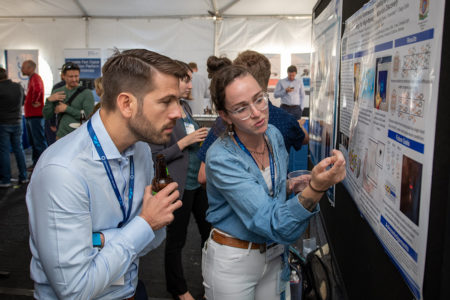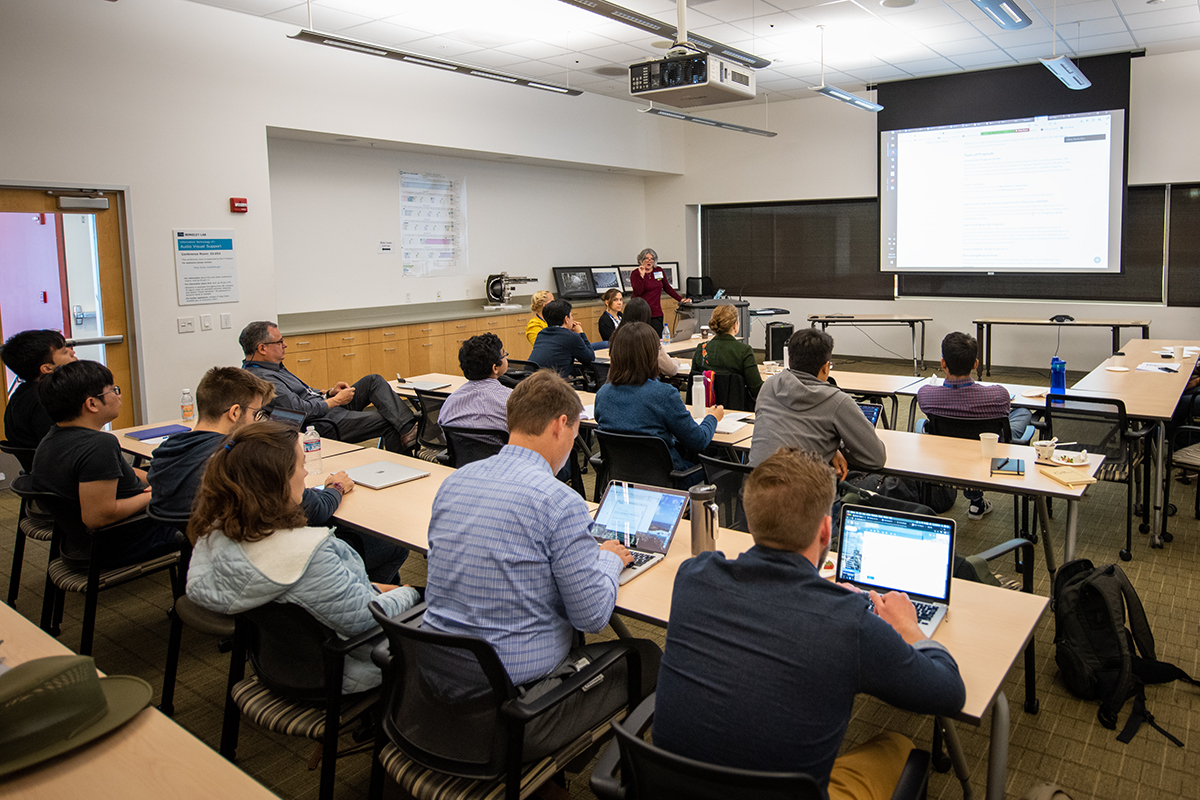
by Lori Tamura
Another successful ALS User Meeting took place in Berkeley, California, on October 1–3, 2019. About 450 ALS users and staff gathered to hear the latest news from Washington, the ALS, and each other. The program, organized by meeting co-chairs Johanna Nelson Weker and Kelsey Stoerzinger with members of the ALS Users’ Executive Committee (UEC), featured a diverse set of scientific talks and a full slate of workshops and tutorials offering deep dives into topics of interest and, for those new to light sources, introductory presentations designed to demystify the light-source experience.
Jeff Neaton, Berkeley Lab’s Associate Laboratory Director for Energy Sciences, officially welcomed the attendees and highlighted several notable things happening this year. The ALS Upgrade Project (ALS-U) recently underwent an encouraging Critical Decision (CD)-3A review, which, if successful, would authorize the start of procurement for long-lead items. Another development is the ramping up of DOE investments in machine learning and artificial intelligence (AI) tools for managing, manipulating, and analyzing data. Neaton also mentioned a couple of new programs at Berkeley Lab—in quantum information science and water desalination—in which the ALS will play a key role. He capped off his remarks with a nod to the ALS’s strong engagement with the Lab’s Inclusion, Diversity, Equity, and Accountability (IDEA) campaign, observing that improving our demographics and culture will be absolutely essential for realizing our scientific mission.

ALS Director Steve Kevan next addressed the assembly, highlighting several projects to improve beam stability, including the use of machine learning to predict and correct beam-size fluctuations and a feedback system for longitudinal stability that will enable “pump-probe-probe-probe-probe” dynamical decay experiments. Kevan also touched on a new “big data” pilot program involving all DOE light sources that he envisions will close the loop between experiment and analysis, with high enough bandwidth to start doing intelligent material discovery. In closing, Kevan discussed several decisions related to ALS-U, including the high-field bend magnet decision and the beamline selection process. He then pivoted to the strategic planning process in general, encouraging users to get involved through upcoming strategic science workshops and user beamline forums.
A DOE update was provided by Linda Horton, director of the Materials Sciences and Engineering Division of the DOE Basic Energy Sciences (BES) Program. After walking through an introduction to BES, she went on to describe the budget process (“Budget 101”), which is still in flux for FY20. Nevertheless, she reported that facilities are expected to continue to do very well. Horton also reiterated the importance of and expanded on exciting new strategic directions in the BES portfolio, including (but not limited to) quantum information science, microelectronics, and machine learning/AI.

Day 1 continued with a full roster of eight science talks, including this year’s Shirley Award talk by Padraic Shafer (ALS) on the fascinating subject for which he was recognized: “Chiral Nanostructures Singled Out by Resonant X-Ray Scattering.” Tabbetha Dobbins (Rowan University) spoke on behalf of a group called LAAAMP (Lightsources for Africa, the Americas, Asia, and Middle East Project). Through grants, LAAAMP builds relationships between scientists from underserved regions and light sources such as the ALS, which hosted two LAAAMP user groups this past summer. Other speakers included Daniela Ushizima (Berkeley Lab’s Computing Research Division), who gave a presentation on “Machine Learning for Materials Imaged at the ALS,” and Hope Ishii (University of Hawaii), who talked about “Exploring the Original Bricks and Mortar of the Solar System.” The ALS website has a complete list of the science talks. A fun poster slam and lively poster session rounded out the day.
On Day 2, an early afternoon plenary session was convened to hear ALS-U updates from Project Director Dave Robin and the Beamlines and Optical Systems Lead, Elaine DiMasi. The first-prize winner of the student poster competition, Shambhavi Pratap (Technical University of Munich, 2018–19 ALS doctoral fellow in residence), also gave her talk on “Understanding the crystallization of solution processed alloys of hybrid perovskites by multimodal characterization.” At the awards dinner that evening, Nobumichi Tamura (ALS) was announced as the winner of the Klaus Halbach Award “for the development of software for analysis of microdiffraction data, which has been critical to the success of science programs at facilities around the world,” and Hans Bechtel (ALS) was presented with the Tim Renner User Services Award “for his dedication to user success, exemplified in the scientific and technical support he provides at the IR beamlines and compassion and inclusion he embodies in every interaction.” Second prize in the student poster competition went to Michael Ziebel (UC Berkeley), and third prize was a tie between Sam Schickler (NASA Ames) and Bibek Samanta (USC).

Workshops and tutorials were the primary focus of Days 2 and 3 (the ALS website has a complete list of workshops). This year, a joint workshop on x-ray photon correlation spectroscopy (XPCS) brought together users from the ALS and NSLS-II to foster collaborations and develop a roadmap for the further development of XPCS, a powerful technique that is uniquely suited to probe heterogeneities and rare events on multiple length and time scales. Also of note were workshops and tutorials focused around a recurring theme this year: addressing the challenges of advanced data management and analysis. One of these workshops focused on the application of machine learning to achieve autonomous experimentation, and another focused on computational challenges across light sources. The popular “Lightsources 101” tutorial, which debuted last year, returned with a couple of additions based on feedback from last year: a module on the basics of synchrotron radiation and one on how to apply for beamtime. At the end of the day, participants were treated to pizza, a perfect way to top off three picture-perfect days at the ALS.
View a photo story about the 2019 User Meeting here.